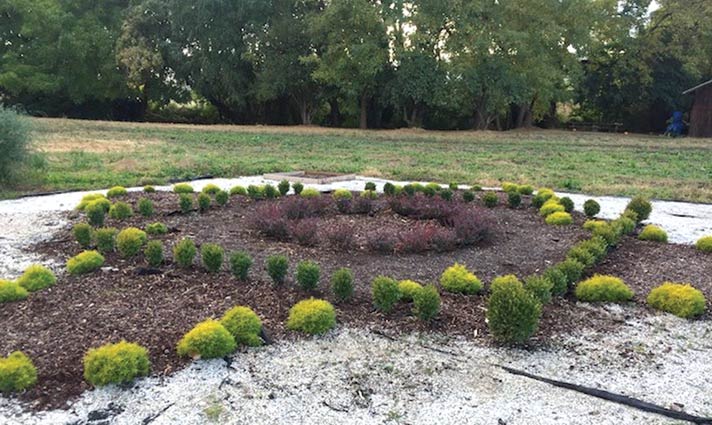The Literary Gardener – March 2018
“It standeth north-north-east
and by east from the west corner of thy curious- knotted garden:
there did I see that low-spirited
swain, that base minnow of thy mirth…”
~William Shakespeare’s Love’s Labor’s Lost, Act I, Scene 1
In this scene, the fantastical Spaniard, Don Adriano de Armado, inserts himself into the Bard’s romantic comedy before he ever steps his fashionable foot onstage through a letter he writes to the King of Navarre. In what amounts to a tattletale note, Don Armado tells King Ferdinand that during a walk in the “curious-knotted garden,” he happened upon the court clown, Costard, “sorting and consorting” with a “country wench” named Jaquenetta.
Actually, Don Armado fancies the maiden for himself. He hopes he’ll get rid of his competition for Jaquenetta by handing over Costard to King Ferdinand. The king has “proclaimed a year’s imprisonment, to be taken with a wench” as part of his decree that the entire court should commit itself to fasting and studying for three years—with no consorting of any kind!
The fact that Don Armado includes the precise location of the knot garden in his letter is just one example of the fun with language that Shakespeare has in the play. In fact, Love’s Labor’s Lost is renowned for the Bard’s use of rhyme, repetition, alliteration, hyphenated neologisms and other kinds of language devices.
As a writer and a writing teacher, I am fascinated by Shakespeare’s brilliant language. As a gardener and botanical Shakespeare enthusiast, I am intrigued by his mention of a knot garden. Shakespeare mentions gardens and gardening dozens of times throughout his plays and poetry; however, Love’s Labor’s Lost contains his one and only mention of a knot garden.
I’m creating a Shakespeare knot garden at the historic Hanley Farm in Central Point. The knot garden is one of five garden tableaux featuring the plants mentioned in some of Shakespeare’s plays. The Love’s Labor’s Lost knot garden includes more than 20 different flowers, herbs, vegetables, vines, shrubs and trees. For more information about The Bard’s Garden at historic Hanley Farm, see my Literary Gardener blog at: http://blogs.esouthernoregon.com/theliterarygardener/.
King Ferdinand’s knot garden serves as a clever plot device because Don Armado describes its location as a way of providing proof to the king that he “did encounter that obscene and preposterous event” between Costard and Jaquenetta. In fact, the value between what one says and writes and what is actually seen and heard becomes an important point of distinction throughout the play. What better place for an unlawful tryst than within the secret twists and turns of a knot garden?
Knot gardens are complicated by design, and Shakespeare uses the king’s knot garden to symbolize all of the comedic complications the characters devise in their misguided labors of love. The formal sophistication of a knot garden also serves as a visual metaphor for the fancy court language that Lord Berowne ridicules as “taffeta phrases, silken terms, and three-piled hyperboles,” but in doing so the courtier, of course, uses ostentatious verbiage himself.
No matter how fancy the language, or the knot garden, it seems the characters in Love’s Labor’s Lost use them for all sorts of less-than-noble pursuits. Perhaps it should be no surprise when love is lost at the end of the play to King Ferdinand and his three lords, at least for the time being. The ladies return to France with only vague promises for the future, and the smooth-talking men are left with only their knot garden and their games of dice and naughty double-entendres to console themselves.
According to Shakespeare scholar and editor H.R. Woudhuysen (1998), all of the male characters in the play treat language as an open, flexible system “in which words can be clipped, bent or melted down like coins to become something other than what they are.” The ladies, on the other hand, comport themselves according to their conviction that words are closed systems with fixed meanings and consequences. Their perspective about language is more like a knot garden—another kind of constructed closed systems carefully tended to create an unbroken border for the flowers and herbs enclosed within.
Regarding the play’s lack of resolution when the final curtain closes, Woudhuysen says, “Shakespeare wants to suggest that people (like the king and his lords) who spurn closed systems of meaning in life, language, and art will ultimately be disappointed…”
Yet, I’m not so sure that was Shakespeare’s ultimate message. After all, he was a master manipulator of language, the quintessential beneficiary of an open, flexible system of language. We may never uncover Shakespeare’s lost sequel play, Love’s Labor’s Won, but the eternal optimist in me believes the ladies come back to the Kingdom of Navarre, and this time the men have learned how to treat language, and the ladies, with more respect.
I am excited to grow a “curious-knotted garden” in The Bard’s Garden at Hanley Farm. Please come visit some time. When you do, you’ll notice a little gap in the knot garden—that’s to let in all of the possibilities.
Featured image: Nowak knot garden at Hanley Farm.

 Rhonda Nowak is a teacher, writer and gardener who lives and works in the Rogue Valley. She has taught literature and language arts for 25 years, the last six at Rogue Community College. In addition to her column for the Jacksonville Review, she writes a weekly column and blog called the Literary Gardener for the Mail Tribune. She also writes articles for Southern Oregon Wine Scene magazine and is writer and editor of Ashland Living magazine. Email Rhonda at Rnowak39@gmail.com.
Read more on her blog at
Rhonda Nowak is a teacher, writer and gardener who lives and works in the Rogue Valley. She has taught literature and language arts for 25 years, the last six at Rogue Community College. In addition to her column for the Jacksonville Review, she writes a weekly column and blog called the Literary Gardener for the Mail Tribune. She also writes articles for Southern Oregon Wine Scene magazine and is writer and editor of Ashland Living magazine. Email Rhonda at Rnowak39@gmail.com.
Read more on her blog at